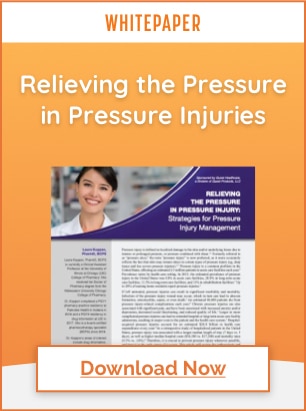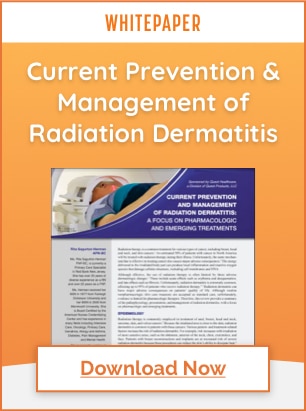
Correlation Between an Ineffective Bowel Care Program and Skin Breakdown
Skin plays an important role in overall health and wellness, particularly for people with limited mobility and/or spinal cord injury or illness.
Skin Integrity & Spinal Cord Injury
When skin is compromised in a healthcare environment, a patient is more susceptible to germs, illness, infection, and injury.
For people with spinal cord injury (SCI), dermatomes aren’t functional below the point of injury, causing the absence of sensation for things like pressure, sharpness, trauma (injury), and temperature. SCI also paralyzes sweating in dermatomes below the injury level, leaving skin vulnerable to breakdown due to excess moisture.
Precautionary measures to prevent skin breakdown are essential for people with SCI to maintain optimum health and wellness.
Common Causes of Skin Breakdown for People with SCI
SCI causes a loss of collagen, which weakens skin and makes it less pliable. Muscle atrophy results in less padding and increased risk of skin breakdown.
A patient’s lifestyle also plays a role in their risk of skin breakdown. Insufficient nutrition, dehydration, stress, lack of range of motion exercise, obesity, depression, substance use, and smoking all increase a patient’s risk of skin breakdown.
Common causes of skin breakdown in the healthcare setting include:
- Shearing and Friction Injuries: A shearing injury typically occurs from sliding the body across a surface, like a bedsheet or chair. With a shearing injury, bone moves against the subcutaneous tissue while the skin stays in the same position. This pressure and movement decreases blood flow to the area, leading to skin breakdown. This may occur with or without visible injury to the surface of the skin.
- Pressure Injury: Limited mobility, coupled with decreased sensation, makes an individual with SCI more likely to develop pressure injuries, which are one of the leading complications for people with SCI. Up to 95% of adults develop at least one pressure injury at some point in their life.
- Excess Moisture: Too much moisture over-hydrates the skin, weakening it and making it more sensitive to friction, shear and breakdown. Primary sources of excess skin moisture include bowel and bladder accidents, sweating, and drainage from wounds.
How an Ineffective Bowel Care Program Can Exacerbate Skin Breakdown
Improper bowel care can create a myriad of skin-related problems, including dermatitis, pressure injuries, perianal skin breakdown, and wound contamination. Skin areas most affected are near the buttocks, hips, genitals, and between the pelvis and rectum (perineum).
Skin problems associated with constipation and fecal incontinence cause risk and discomfort to patients, reduced quality of life and independence, and increased costs to healthcare providers and institutions.
An effective bowel care program helps avoid bowel accidents and is an important element to keeping skin dry and away from damaging bacteria.
Fecal Incontinence and Skin Breakdown
Exposure to urine and feces is one of the most common causes of skin breakdown. Did you know that fecal incontinence is hypothesized to act as a more potent risk factor for skin breakdown than urinary incontinence?
Here are some of the more common incontinence related skin problems:
- Maceration: Over-exposure to moisture causes maceration of the skin and makes the skin very fragile. Once skin is macerated, even gentle rubbing by bed linens, diapers, and washcloths can cause injury.
- Incontinence Dermatitis: Otherwise known as perineal dermatitis or diaper rash, this condition involves the irritation and breakdown of the skin as a result of over-exposure to moisture and chemicals in urine and feces.
- Fungal Infection: Damp, warm skin environment generally associated with incontinence is ideal for the proliferation of pathogenic fungi.
- Bacterial Infection: Incontinence allows the skin’s surface to contact bacteria from waste products. This is particularly dangerous for the elderly, whose skin may be characteristically dry. Dry skin provides an opportune breeding ground for bacterial growth since micro-organisms can be absorbed through skin cracks and fissures.
The Cost of Incontinence
The costs of bowel related care to healthcare providers and institutions is high, about $9,771 per patient annually, including staffing costs (nursing and care staff spend nearly an hour per day, per patient, managing bowels and related issues), laundry, and incontinence supply costs.
Skin breakdowns due to poor bowel management can lead to wound contamination, which also gives rise to longer hospital stays and increased healthcare costs.
Effective management of acute fecal incontinence and timely interventions will help prevent maceration, skin breakdown, and potential wound contamination, all of which are costly to both patients and caregivers.
Enemeez® and Bowel Care
Enemeez® has several advantages over bisacodyl suppositories and other forms of bowel management.
Two-thirds of all bisacodyl suppository users regularly experienced mucous discharge, bleeding, or an episode of incontinence, which reduces a person’s quality of life and puts them at increased risk for skin breakdown and other incontinence related health problems. Bisacodyl users are twice as likely to have an episode of incontinence following a bowel care session than Enemeez® users.
In addition, reduced time spent sitting on a commode by Enemeez® users may reduce the risk of pelvic pressure injuries development. Incontinent patients are 22 times more likely to develop a pressure injury. The cost to treat can be upwards of $70,000.
Including Enemeez® products in your facility’s regimented bowel care program is a safe, proven, and effective way to maintain your patients’ bowel health, improve their quality of life and may reduce costs associated with fecal incontinence.
Disclaimer: The material contained is for reference purposes only. Alliance Labs, LLC and Summit Pharmaceuticals do not assume responsibility for patient care. Consult a physician prior to use. Copyright 2021 Summit Pharmaceuticals and Alliance Labs, LLC.
Sources:
- Nix DH. Validity and reliability of the Perineal Assessment Tool. Ostomy Wound Manage. 2002;48(2):43–49.
- Maklebust JA, Magnan MA. Risk factors associated with having a pressure ulcer: a secondary data analysis. Adv Wound Care. 1994;7(5):25–42.
- Mode of action. Alliance Labs in-house research. Customer Survey Feb 21, 2014
- Federal Register / Vol. 50, No. 10 / Tuesday, January 15, 1985 / Proposed Rules; pgs. 2124-2158.
- Alliance Labs In-house research. Customer Survey 4.27.2011.
- https://alliancelabsprovider.com/enemeez-pharmacoeconomic-evaluation/
- Incontinence in Institutions: Costs and Contributing Factors, Michael J. Borrie, MB, ChB; Heather A. Davidson, PhD




![[Live Webinar] Neurogenic Bowel Dysfunction in Multiple Sclerosis](https://www.questhealthcare.net/wp-content/uploads/2025/02/325-Quest-Healthcare-Speaker-Session-1-500x383.png)


